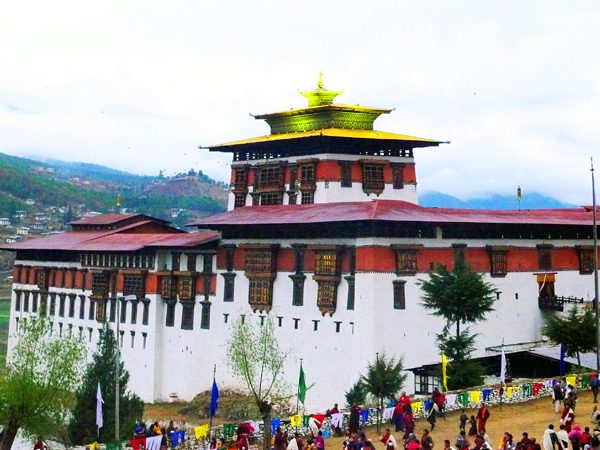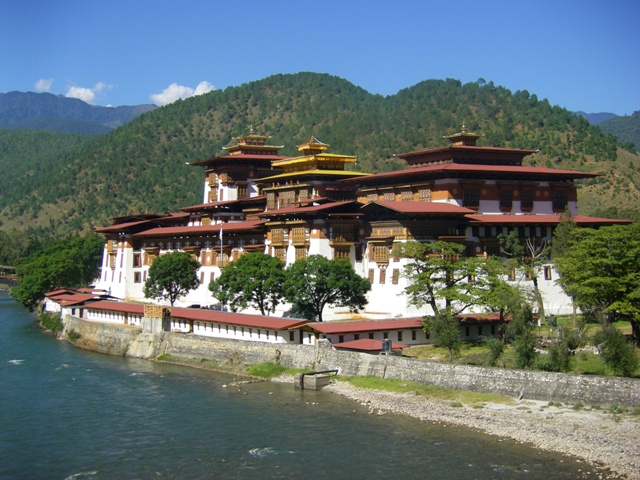Bhutan Culture & Nature Tour
Paro-Thimphu-Punakha-Wangduephodrang-Trongsa-Bumthang-Wangduephodrang-Paro
Day 1: Paro
 On a clear day, the flight to Paro is one of the most spectacular of all mountain flights. Whether flying along the Himalayan range from Kathmandyoung archer Bhutanu or over foothills from Kolkatta, the journey offers you wonderful views of the Himalayas and an exciting descent into the Kingdom.
On a clear day, the flight to Paro is one of the most spectacular of all mountain flights. Whether flying along the Himalayan range from Kathmandyoung archer Bhutanu or over foothills from Kolkatta, the journey offers you wonderful views of the Himalayas and an exciting descent into the Kingdom.
Day 2: Paro
 After breakfast, visit Ta Dzong (National Museum) formerly a wtchtower and now the National Museum. The museum collection includes ancient Bhutanese art and artifacts, weapons, coins, stamps and a small natural history collection. Then walk down a hillside trail to visit Rinpung Dzong (Paro Dzong) situated at a commanding height overlooking Paro valley. Built by Shabdrung Ngawang Namgyal in 1646, this dzong now houses Paros monk body and the offices of the civil administration and is symbolic as the religious and secular centre of all affairs of the valley.
After breakfast, visit Ta Dzong (National Museum) formerly a wtchtower and now the National Museum. The museum collection includes ancient Bhutanese art and artifacts, weapons, coins, stamps and a small natural history collection. Then walk down a hillside trail to visit Rinpung Dzong (Paro Dzong) situated at a commanding height overlooking Paro valley. Built by Shabdrung Ngawang Namgyal in 1646, this dzong now houses Paros monk body and the offices of the civil administration and is symbolic as the religious and secular centre of all affairs of the valley.
 After breakfast proceed to Thimphu, the modern capital town of Bhutan. Enroute stop at Chuzom (confluence) where Paro river joins Thimphu river. Nearby Thimphu, visit Simtokha Dzong, the oldest fortress of the Kingdom which now houses the School for Buddhist studies.
After breakfast proceed to Thimphu, the modern capital town of Bhutan. Enroute stop at Chuzom (confluence) where Paro river joins Thimphu river. Nearby Thimphu, visit Simtokha Dzong, the oldest fortress of the Kingdom which now houses the School for Buddhist studies.
Day 4: Thimphu
 Morning, Thimphu sightseeing, visiting National Library, Painting School and Traditional Medicine Institute.
Morning, Thimphu sightseeing, visiting National Library, Painting School and Traditional Medicine Institute.
 After breakfast drive to Gangtey via Wangduephodrang. Visit majestic Wangdue Dzong and interesting local market.
After breakfast drive to Gangtey via Wangduephodrang. Visit majestic Wangdue Dzong and interesting local market.
Day 6: Punakha
 Morning explore Phobjikha valley which is famous for Black Necked Cranes. The cranes migrate here from Central Asiatic plateau to escape its harsh winters.
Morning explore Phobjikha valley which is famous for Black Necked Cranes. The cranes migrate here from Central Asiatic plateau to escape its harsh winters.
Day 7: Punakha - Wangduephodrang
 Morning visit Trongsa Dzong, the master piece of Bhutanese architecture and see Ta Dzong, the watch tower, built to defend this Dzong and surrounding region.
Morning visit Trongsa Dzong, the master piece of Bhutanese architecture and see Ta Dzong, the watch tower, built to defend this Dzong and surrounding region.
Day 8: Wangduephodrang
 Bumthang is the general name given to combination of four valleys – Chumey, Choekhor, Tang and Ura with altitude varying from 2,600m to 4,000m. It is home to many of prominent Buddhist temples and monasteries.
Bumthang is the general name given to combination of four valleys – Chumey, Choekhor, Tang and Ura with altitude varying from 2,600m to 4,000m. It is home to many of prominent Buddhist temples and monasteries.
Day 9: Wangduephodrang - Trongsa
 Bumthang to Ura is 48 km, about one and a half hour drive. To reach here, the road climbs to amazingly open countryside, only occasionally running into forest. Large sheep pastures line the road up to 20 km behind the southern tip of the Tang valley. The route crosses Ura la pass (3,600m) with a magnificent view of Mount. Gangkhar Puensum. Villages in Ura have clustered houses, which is quite unusual in Bhutan. Above Ura village (3,100m) is a new temple dedicated to Guru Rinpoche. Inaugurated in 1986, it contains a huge statue of the master and remarkable paintings of the cycle of his teachings. Since last 25 years Ura has been transformed from a marginal community to prosperous valley.
Bumthang to Ura is 48 km, about one and a half hour drive. To reach here, the road climbs to amazingly open countryside, only occasionally running into forest. Large sheep pastures line the road up to 20 km behind the southern tip of the Tang valley. The route crosses Ura la pass (3,600m) with a magnificent view of Mount. Gangkhar Puensum. Villages in Ura have clustered houses, which is quite unusual in Bhutan. Above Ura village (3,100m) is a new temple dedicated to Guru Rinpoche. Inaugurated in 1986, it contains a huge statue of the master and remarkable paintings of the cycle of his teachings. Since last 25 years Ura has been transformed from a marginal community to prosperous valley.
Day 10: Trongsa
 Morning after visiting Bumthang market, drive to Wangdue . Lunch would be served enroute at one of the famous restaurant in Trongsa town.
Morning after visiting Bumthang market, drive to Wangdue . Lunch would be served enroute at one of the famous restaurant in Trongsa town.
 Morning excursion to Chimi Lhakhang, situated on a hillock in the centre of the valley, is dedicated to Lama Drukpa Kuenley, who in the late 15th century used humour, songs and outrageous behaviour to dramatise his teachings and due to this also known as "Divine Madman". This temple is also known as the temple of fertility. It is widely believed that couples who do not have children and wanting one, if they pray at this temple, they are usually blessed with a child very soon. It is about 30 minute walk across field from the road to the temple. The trail leads across rice fields to the tiny settlement of Pana, meaning field. It then follows a tiny stream downhill to Yoaka and across more fields before making a short climb to Chimi Lhakhang.
Morning excursion to Chimi Lhakhang, situated on a hillock in the centre of the valley, is dedicated to Lama Drukpa Kuenley, who in the late 15th century used humour, songs and outrageous behaviour to dramatise his teachings and due to this also known as "Divine Madman". This temple is also known as the temple of fertility. It is widely believed that couples who do not have children and wanting one, if they pray at this temple, they are usually blessed with a child very soon. It is about 30 minute walk across field from the road to the temple. The trail leads across rice fields to the tiny settlement of Pana, meaning field. It then follows a tiny stream downhill to Yoaka and across more fields before making a short climb to Chimi Lhakhang.
Day 12: Bumthang
 Start the day early for drive to Haa via Chele-la pass. 4 Km away at chele la passBondey village the road to Haa diverts towards the right hand side and the climb up towards the chele-la pass starts. After driving through blue pine & rhododendron forest for 45 km, reach Chele-la pass ( 4200 meters). From this point one can have a superb views of Mount. Chomolhari & Jichu Drakey. This is a very good place to walk around for few minutes enjoying the view. Drive on to Haa, descending all the way for another 22 km (under an hours drive), finally reaching Haa. The Haa Dzong is presently occupied by military, but the view from outside is stunning. After picnic lunch visit the famous Monastery Lhakhang Karpo (White Temple) followed by visit Lhakhang Nagpo (Black Temple). The central shrine in Lhakhang Nagpo is said to have no difference with that of Lhasa JOWO in Tibet. The construction of the Lakhang Karpo is believed to have been assisted by the locality. As a result the place came to be locally known as Hay meaning surprise which later became Haa due to the differences in interpretations and pronunciations of different people over time.
Start the day early for drive to Haa via Chele-la pass. 4 Km away at chele la passBondey village the road to Haa diverts towards the right hand side and the climb up towards the chele-la pass starts. After driving through blue pine & rhododendron forest for 45 km, reach Chele-la pass ( 4200 meters). From this point one can have a superb views of Mount. Chomolhari & Jichu Drakey. This is a very good place to walk around for few minutes enjoying the view. Drive on to Haa, descending all the way for another 22 km (under an hours drive), finally reaching Haa. The Haa Dzong is presently occupied by military, but the view from outside is stunning. After picnic lunch visit the famous Monastery Lhakhang Karpo (White Temple) followed by visit Lhakhang Nagpo (Black Temple). The central shrine in Lhakhang Nagpo is said to have no difference with that of Lhasa JOWO in Tibet. The construction of the Lakhang Karpo is believed to have been assisted by the locality. As a result the place came to be locally known as Hay meaning surprise which later became Haa due to the differences in interpretations and pronunciations of different people over time.
Day 13: Bumthang
 After breakfast transfer to the airport for flight to onward destination.
After breakfast transfer to the airport for flight to onward destination.























